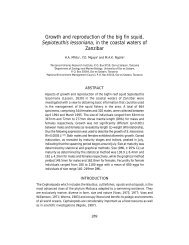Source: Mwaguni & Munga 1997Sewage Discharge RatesDischarge Rates –cubic meters per daySource Design Flow Current Flow ProjectedChangamwe Stage 1 17 100 Unknown 51 300Kizingo 31 400 Unknown 94 200Environmental Impacts and Resources AffectedFresh water. Mombasa District has no surface water resources of its own. The Districtdepends on surface water supplies from Baricho in Malindi District. This source experienceslow flows during the dry season and siltation causes frequent breakdowns during the rainseason resulting into perennial water shortages in Mombasa. Groundwater sources is themain source of water supply to the population of Mombasa supplementing surface water, butdue to inadequate water management, lack of distribution infrastructure and proximity to humansettlements, ground water sources are saline or contaminated with feacal matter. Studies byMwaguni & Munga- 1993, 1997 and Mwaguni 1999, have confirmed that all ground watersources developed alongside human settlement did not pass the test for drinking water. Onlythose sources developed far away from human habitation passed the standards for drinkingwater. Since the largest number of the sources have been developed near or within humansettlements, treatment of such sources to make them potable is not sustainable because of thepresence of the permanent sources of contamination from pit latrines and soakage pits.Microbial contamination of ground water in Mombasa DistrictSource No Coliform count per100mlE. Coli count per 100ml Potability*WellsWellsBoreholesBoreholes203111#25-1800+0 – 417-1800+00-1800+00-500101Source: Mwaguni & Munga 1997* Potability: 0 - not potable, 1 - potable# Borehole water treated with ultra-violet radiationDrinking water standards applied in Kenya are: -(a) Coliform count < 10/100ml, (b) E. Coli count, nilMarine and Coastal Ecosystems. Important marine and coastal ecosystems on the KenyaCoast include: Coral reefs, beaches, mangroves, lagoons, coastal and Kaya forests, marine andinland reserves and historical sites. Coastal reefs support a rich diversity of species and protectthe shoreline from wave action. Mangrove habitat form important nursery grounds for a varietyof fishes and crustacean, for various species of sea birds, act as nutrient trap that help reducepollution loads to the marine environment in addition to providing stability of the shorelineagainst erosion. Biodiversity in intertidal mangrove forests is usually high. Between the reefsystem and the shoreline are the biologically productive lagoons, which are critical to fishingactivities. The sandy beaches and sea grasses are ideal for numerous marine creatures,providing nestling grounds for various species of turtles, fishes and mollusks. The lowland andKaya forests support a high diversity of flora and fauna.• Pollution from industrial effluents and sewage and development pressures create impactson these eco-systems leading to their degradation.• Snorkellers trample on coral reefs, the reefs suffer anchor damage in addition to sufferingthe consequences of degraded water quality through oil pollution, siltation and thedischarges of sewage.• Mangroves suffer from over-cutting, pollution from oil spills and waste dumping and fromthe effects of sedimentation and improper oyster harvesting. The consequences of this isthe decline of fuel wood and mangrove poles for building, loss of livelihood for mangroveharvesters and loss of breeding habitat for fisheries and associated impact on fish catch.Final Draft Report – Cost Benefit Case StudiesGPA Strategic Action Plan on Sewage, October, 200074
• The clearing of mangroves, coastal and kaya forests, and increased development and usesof the beach have resulted into the erosion of the beaches and the coastline with theconsequent losses of nestling habitats for turtles and loss of scenic and aesthetic qualitiesfor tourism.• Decline in water quality, beach erosion and sedimentation have also led to the degradationof sea grasses.• Fish habitats (Coral reefs and mangroves) have been degraded with consequent loss ofbreeding and spawning habitats for fish leading to decline in fish production.• Reduced fish production also reduces incomes to fishermen with corresponding increasedprices for buyers.• Public health threats associated with drinking contaminated water, the consumption ofcontaminated seafood and recreational contact.• Degraded environmental quality results in the decline of tourist visits and loss of means oflivelihood to boat and tour operators from businesses and tourism associated revenues.Health Impacts and threat - Indicators of Health Problems. Due to various types of waterborne diseases, which afflict children, the source of water for domestic use has and methodsof sewage disposal direct affect the level of child mortality and morbidity. It is reported in theKenya Population Census (1989) Analytical Report on Child Mortality that the proportions ofchild mortality was directly related to the various sources of water in relation to their qualityattributes. Lakewater was reported as the most important factor responsible for high childmortality. Important differences are reported in child mortality by means of sewage disposal, akind of dose-response function: The use of main sewer yielded the lowest proportions of childmortality, while disposal of sewage in the bush resulted in the highest child mortality. Onaverage, use of the bush disposal method increases child mortality by about 53% ascompared to use of main sewer. Indiscriminate use of small plastic containers to dispose ofwaste matter is commonplace in Mombasa, a phenomenon commonly referred to as “flyingtoilets”. Such disposal methods are common responses to the lack of infrastructure underconditions of rapidly growing population, poverty and public sector financial stringency.Spontaneous methods of waste disposal are contributory factors to the prevalence of waterbornediseases such as malaria, diarrhoel diseases and worms. These diseases have been themajor causes of death among the infants as reported above. According to the Economic Surveyof 1996, the mortality rate in Mombasa was 60/1000 for infants under 1 year.The national average reported was 66/1000. No statistics could be found for children betweenthe ages 1 and 5 years for the same period for Mombasa. However, national statistics for 1998indicate that mortality in general has gone up across the board. This increase in mortality isattributed to the HIV/AIDS pandemic. Figures cited indicate mortality of 74/1000 for infants and112/1000 for children between the ages 1 and 5 years.Malaria has been singled out as the major cause of death among children between the ages of1 and 5 killing 107/1000 children. It kills 72 children daily and accounts for 30% of all outpatient<strong>case</strong>s and 19% of admissions, 5.1% of who die. The major diseases reported in Mombasainclude malaria, pneumonia, tuberculosis, diarrhea and anemia. Recently typhoid has emergedto as one of the most devastating water-borne disease. In 1994, malaria constituted 33.4% of all<strong>case</strong>s reported, while pneumonia was 19.5%. Tuberculosis recorded 19.8%; diarhoeal diseasesconstituted 8%, while the rest recorded 19.1%.Out Patient Morbidity in the District of Mombasa 1994Diseases Island Kisauni Changamwe Likoni Total %MalariaRespiratorySkin InfectionDiarrhoeaOthers43,73232,53312,53410,18421,36525,80916,07810,7228,5175,67931,92114,7038,6027,6374,64825,56010,8225,9284,2054,757127,02274,13675,57230,54372,89833.419.519.88.019.1Source: Municipal Council of MombasaA <strong>case</strong> is reported in February-March 1999, in Mombasa, where a sewer line burstcontaminated the main reticulated water supply with the following consequences: 470 out ofFinal Draft Report – Cost Benefit Case StudiesGPA Strategic Action Plan on Sewage, October, 200075



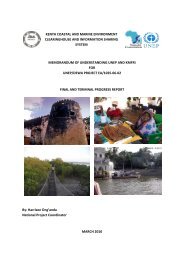
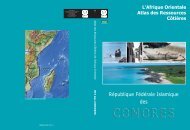
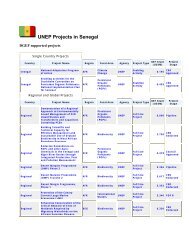

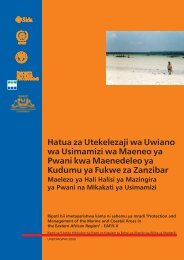
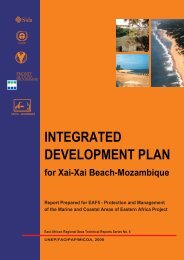
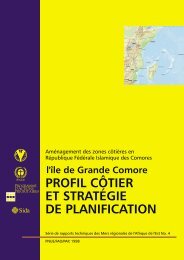
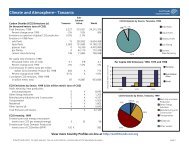

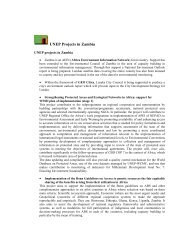
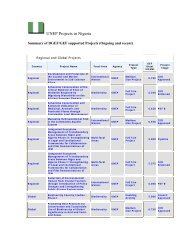
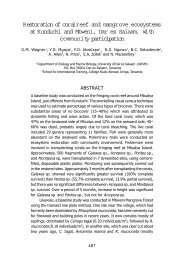
![Please Click to download [English] - GRID Africa GeoPortal - UNEP](https://img.yumpu.com/30633391/1/184x260/please-click-to-download-english-grid-africa-geoportal-unep.jpg?quality=85)
